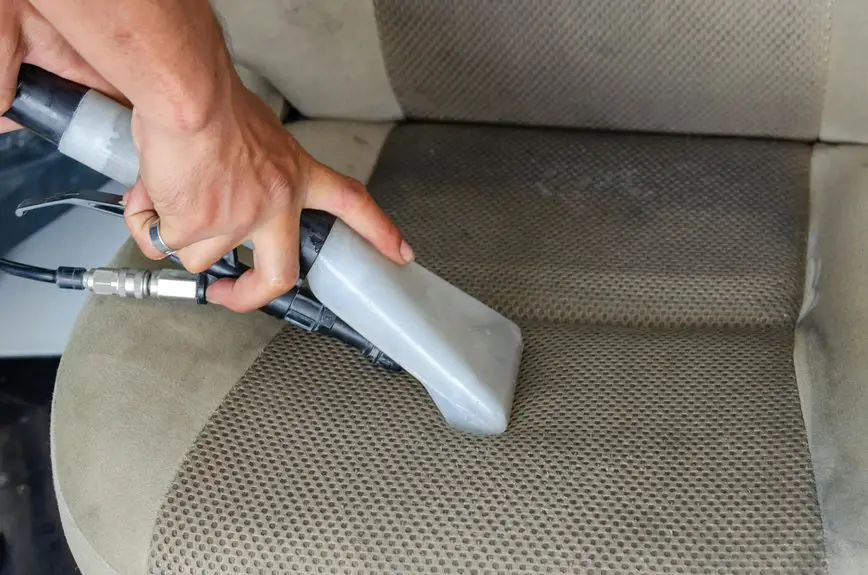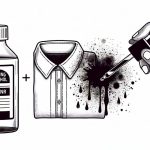To get grease and oil stains out of upholstery, first check your fabric type and tag for cleaning codes. Blot the stain gently with a dry cloth to soak excess oil, then sprinkle baking soda or cornstarch to absorb it. Use mild dish soap or rubbing alcohol on a clean cloth to dab the spot, testing first on a hidden area. Avoid rubbing to prevent spreading. If the stain persists or fabric is delicate, professional help may be best. Keep exploring for more detailed tips and solutions.
Table of Contents
Key Takeaways
- Identify upholstery fabric type and check cleaning codes to select safe stain removal methods.
- Blot grease stains immediately with a dry cloth to absorb excess oil without rubbing.
- Sprinkle baking soda or cornstarch on the stain to absorb oil, then vacuum after 15 minutes.
- Apply a mixture of dish soap and water, gently dab with a clean cloth to break down grease.
- If stains persist or fabric is delicate, seek professional upholstery cleaning services.
Identifying the Type of Upholstery Fabric
Before you tackle grease and oil stains, you need to identify the type of upholstery fabric you’re dealing with. Different fabrics react differently to cleaning methods, so knowing what you have is essential.
Check the manufacturer’s tag for cleaning codes like W, S, WS, or X, which tell you what solvents or water-based cleaners are safe. If there’s no tag, you can perform a small spot test on an inconspicuous area using water or a mild cleaner to see how the fabric reacts.
Natural fibers like cotton or linen absorb stains faster, while synthetics like polyester repel liquids more, affecting stain removal methods. Identifying the fabric guarantees you choose the safest, most effective approach without damaging your upholstery.
Immediate Steps to Take When Stains Occur
When grease or oil hits your upholstery, act quickly to prevent the stain from setting. The faster you respond, the easier it will be to remove the mark.
Start by gently blotting the area to soak up excess oil without rubbing it deeper in. Then, follow these immediate steps:
- Use a clean, dry cloth or paper towel to blot the stain.
- Avoid scrubbing, which spreads the grease further.
- Sprinkle a small amount of baking soda or cornstarch to absorb oil.
- Let the powder sit for 10-15 minutes before gently brushing it off.
- Keep pets and children away to prevent accidental spreading.
Taking these quick actions buys you time before you apply cleaning solutions in the next steps.
Using Household Items to Treat the Stain
You can tackle grease and oil stains using common household cleaners like dish soap or baking soda.
Applying these items correctly is key, so you’ll want to use gentle blotting or scrubbing techniques depending on the fabric.
With the right approach, these simple tips can make a big difference in removing stubborn stains.
Common Household Cleaners
Although professional cleaners can tackle tough stains, you don’t always need them to remove grease and oil from upholstery. You can rely on common household cleaners that are effective and usually on hand.
These simple items break down grease and lift oil without harsh chemicals, making your cleanup easier.
Try these household cleaners for grease and oil stains:
- Dish soap: Cuts through grease effectively.
- Baking soda: Absorbs oil and neutralizes odors.
- White vinegar: Helps break down residue.
- Cornstarch: Draws out and absorbs oil.
- Rubbing alcohol: Dissolves grease gently.
Using these cleaners can save you time and money while restoring your upholstery’s appearance safely.
Application Techniques
Household cleaners offer great potential, but applying them correctly makes all the difference in removing grease and oil stains from upholstery.
First, always test your chosen cleaner on a hidden spot to avoid color damage. When treating the stain, use a clean white cloth or sponge to prevent color transfer.
Apply the cleaner gently, dabbing rather than rubbing, to lift the stain without spreading it. For powders like baking soda or cornstarch, sprinkle generously on the stain and let it sit to absorb the oil before vacuuming.
If using a liquid cleaner, apply it sparingly to avoid over-wetting the fabric. Work from the stain’s edges inward to contain it.
Finally, blot with a dry cloth to remove excess moisture and cleaner residue.
Stain Removal Tips
Three common kitchen staples—baking soda, white vinegar, and dish soap—can work wonders on grease and oil stains in upholstery.
Start by sprinkling baking soda on the stain to absorb excess oil. After 15 minutes, vacuum it up.
Next, mix a tablespoon of dish soap with two cups of warm water. Dab this solution onto the stain using a clean cloth. For stubborn stains, add a splash of white vinegar to the mixture. Blot gently without rubbing, then rinse with a damp cloth.
- Test cleaning solutions on a hidden spot first
- Avoid soaking the fabric to prevent damage
- Use a clean cloth for each step
- Work from the stain’s edge inward
- Let the upholstery air dry completely
These tips help restore your upholstery quickly and safely.
Applying Commercial Upholstery Cleaners Safely
When you use commercial upholstery cleaners, you should always test them on a small, hidden area first to avoid damage or discoloration.
Apply a small amount, wait a few minutes, then check for any adverse reactions. If the fabric looks unchanged, proceed with the stain treatment.
Test a small area first, wait, and ensure no damage before treating the stain.
Use the cleaner sparingly, following the product instructions closely. Avoid soaking the fabric, as excess moisture can lead to mold or damage.
Apply the cleaner with a soft cloth or sponge, gently blotting the stain instead of rubbing, which can spread it. Work from the outside toward the center to prevent enlarging the stain.
Always guarantee good ventilation while cleaning to avoid inhaling fumes.
Tips for Drying and Preventing Stain Residue
Although removing grease and oil stains is essential, drying your upholstery properly is just as important to prevent residue and further damage.
After cleaning, moisture left behind can attract dirt and cause mildew. To dry and avoid residue, follow these tips:
- Blot the area gently with a clean, dry cloth to remove excess moisture.
- Use a fan or open windows to increase air circulation.
- Avoid direct heat like hairdryers, which can set stains or damage fabric.
- Allow the upholstery to dry completely before using it again.
- If possible, lift cushions to let air reach both sides.
Proper drying guarantees your upholstery stays fresh and stain-free longer.
Take your time to let it dry thoroughly for the best results.
When to Seek Professional Upholstery Cleaning Services
How do you know if your upholstery needs professional cleaning after dealing with grease and oil stains?
If stains persist despite your best efforts or if the fabric is delicate or vintage, it’s time to call in experts. Professionals have specialized tools and cleaning agents that can remove deep-set grease without damaging your upholstery.
Additionally, if your furniture covers a large area or has complex designs, DIY methods mightn’t be practical. Don’t wait if odors linger or if the stain spreads after cleaning attempts—these signs mean professional intervention is required.
Seeking professional services guarantees thorough cleaning, helps preserve your upholstery’s integrity, and saves you time and frustration. When in doubt, entrust your furniture to trained cleaners for the best results.
Frequently Asked Questions
Can Upholstery Stain Removers Damage Fabric Colors?
Think of your fabric as a delicate painting; using harsh stain removers can fade its vibrant story. You should always test removers on a hidden spot first, so you don’t risk dulling or damaging the colors.
How Often Should Upholstery Be Professionally Cleaned?
You should get your upholstery professionally cleaned every 12 to 18 months to keep it fresh and extend its life. If you have pets or allergies, consider cleaning it more often to maintain a healthy environment.
Are Oil Stains More Common on Certain Upholstery Types?
Oil stains tend to favor fabrics that invite a little extra attention, like delicate silks or soft leathers. You’ll notice they show up more often on these, so you’ll want to handle them with extra care.
Can Pet Oils Cause Similar Stains on Upholstery?
Yes, pet oils can cause similar stains on upholstery. You’ll notice oily spots from your pet’s natural skin oils, especially if they lie on furniture often. Regular cleaning helps prevent buildup and keeps fabric fresh.
What Long-Term Damage Can Grease Stains Cause if Untreated?
Grease stains, like unwelcome shadows, seep deep, weakening fabric fibers and attracting dirt. If you don’t treat them, they’ll leave permanent marks, cause discoloration, and eventually degrade your upholstery’s look and lifespan.
- Recycling Nonwoven Fabrics: Is It Possible? - July 11, 2025
- Recycling Nonwoven Fabrics: Is It Possible? - July 11, 2025
- Recycling Nonwoven Fabrics: Is It Possible? - July 11, 2025







